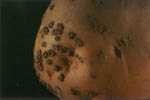
The fungus, Spongospora subterranea, may infect all the underground parts of the potato plant; however, scab on the tuber is the most important aspect of this disease. Tuber and root infection are favoured by cool, moist soil conditions. The fungus may persist in the soil for 6 or more years. It seldom occurs in Atlantic Canada.
Early infection is evident as small, purplish-brown pimples or small, white, wart-like growths on the tuber surface. The white outgrowths may be confused with enlarged lenticels (breathing pores) that form in wet soils. These growths darken and decay, leaving a shallow scab-like depression filled with a powdery mass of dark brown spores. The scab is usually surrounded by a raised torn edge of the skin. Although powdery scab and common scab are separate diseases, positive identification by visual symptoms may be difficult. However, powdery scab can be identified easily with the use of a microscope.
